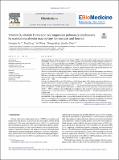Vitamin D₃-vitamin D receptor axis suppresses pulmonary emphysema by maintaining alveolar macrophage homeostasis and function
Author(s)
Hu, Guangan; Dong, Ting; Chen, Jianzhu
DownloadPublished version (4.122Mb)
Terms of use
Metadata
Show full item recordAbstract
Background: Chronic obstructive pulmonary disease (COPD) is characterized by emphysema and/or obstructive bronchiolitis. Deficiency in vitamin D3 (VD3), which regulates gene expression through binding to vitamin D receptor (VDR), is associated with high risks of COPD susceptibility. Alveolar macrophages (AM), which are generated during early ontogeny and maintained in alveoli by self-renewal in response to cytokine GM-CSF, are positively correlated with severity of emphysema. However, whether and how VD3, VDR and AM interact to contribute to COPD pathogenesis at the molecular and cellular levels are largely unknown. Methods: We used systems biology approaches to analyze gene expression in mouse macrophages from different tissues to identify key transcription factors (TF) for AM and infer COPD disease genes. We used RNA-seq and ChIP-seq to identify genes that are regulated by VD3 in AM. We used VDR-deficient (Vdr−/−) mice to investigate the role of VD3-VDR axis in the pathogenesis of COPD and characterized the transcriptional and functional alterations of Vdr−/− AM. Findings: We find that VDR is a key TF for AM and a COPD disease gene. VDR is highly expressed in AM and in response to VD3 inhibits GM-CSF-induced AM proliferation. In Vdr−/− AM, genes involved in proliferation and immune response are upregulated. Consistently, Vdr−/− mice progressively accumulate AM and concomitantly develop emphysema without apparent infiltration of immune cells into the lung tissue. Intratracheal transfer of Vdr−/− AM into wildtype mice readily induces emphysema. The production of reactive oxygen species at basal level and in response to heme or lipopolysaccharide is elevated in Vdr−/− AM and suppressed by VD3 in wildtype AM. Interpretation: These results show that the VD3-VDR axis is critical to counteract GM-CSF-induced AM proliferation and defect in this regulation leads to altered AM homeostasis and function. Our findings identify that VD3 deficiency contributes to emphysema by altering AM function without contributing to bronchiolitis. Our findings also suggest possibilities of modulating the VD3-VDR axis for inhibiting emphysema in COPD patients.
Date issued
2019-07Department
Massachusetts Institute of Technology. Department of Biology; Koch Institute for Integrative Cancer Research at MITJournal
EBioMedicine
Publisher
Elsevier BV
Citation
Hu, Guangan et al. “Vitamin D₃-vitamin D receptor axis suppresses pulmonary emphysema by maintaining alveolar macrophage homeostasis and function.” EBioMedicine, vol. 45, 2019, pp. 562-577 © 2019 The Author(s)
Version: Final published version
ISSN
2352-3964